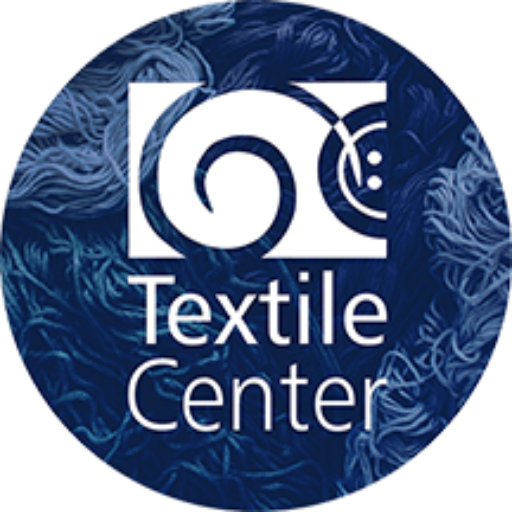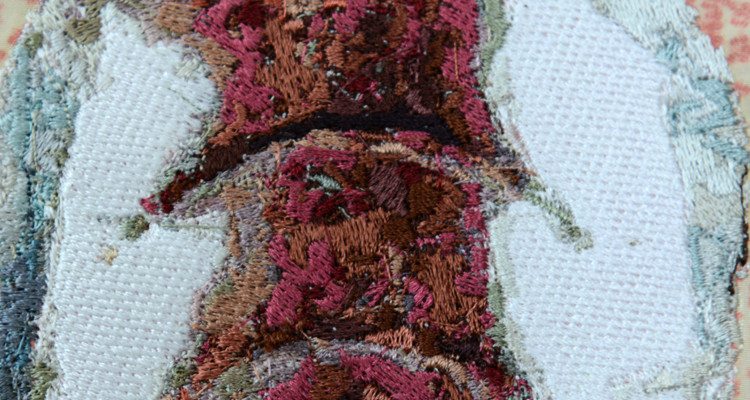July 14 – October 25, 2014 • Studio Gallery • Jessica Larson
Artist Talk: Thursday August 14, 6 pm
“I wanted to challenge the gut reaction to see the pads as something beyond nasty—when you think about how many humans have this in common…how could it be so awful?”
—Jessica Larson
Combining interests in anthropology, abstraction, and Kiki Smith’s art involving the female body, artist Jessica Larson’s new series mines issues of taboos and attraction versus repulsion. Turning the traditional concept of embroidery work on its head, Woman Troubles begs the question, “Can something be so ugly that it’s beautiful?”
These stitches are working to say something that feels far from the traditional, polite embroidery of the past. Embroidery techniques have been used to “prettify” textiles, yet the less attractive topic of menstrual cycles conflicts with one’s automatic association with embroidery.
Larson’s imagery uses the common language of menstruation—so common that upon viewing, women respond to individual pads with the exclamation, “I’ve had that one”—to facilitate a public conversation about a private topic.
Although the individual pieces may be similar, there is a compulsion to see meaning into them. Akin to reading tarot cards, we may contemplate their messages to better understand the divinations of the female body. It is a funny, absurd exercise, imagining a world where the blood tells your fortune.
Above: detail, Woman Troubles. Materials: Embroidery floss, silk taffesta. Technique: Image editing in Photoshop and Illustrator, inkjet printing, digitized machine embroidery, hand stitching
Jessica Larson Biography
Jess Larson was born and raised in West Central Minnesota, and received her undergraduate degree at the University of Minnesota, Morris in 1992. She did her graduate work at the University of Colorado at Boulder, completing a Masters of Fine Arts in Sculpture in 1995. Larson returned to the University of Minnesota, Morris in 1995 as a member of the Studio Arts Faculty, and continues to work at the institution teaching foundation courses, drawing, digital imaging, sculpture, and photography. Her work has been shown nationally and internationally in various group and solo shows, including the Spoletto Piccolo Festival and the Jerome Book Arts Exhibition at the Minnesota Center for the Book Arts.
Artist Statement, 2011
My ongoing creative work recontextualizes and subverts common objects or beliefs as a proxy to examine the complex terrain that women must navigate to shape an identity within a culture offering mixed directives in that pursuit. The conceptual goal is to illuminate the paucity of positive, if not reasonable, feminist social messages by specifically delving into the morass of negative ones in order to reclaim or destroy them from within. Interjecting humor into the critique not only exploits the absurd agendas of such “norms,” but also creates a more hospitable situation to introduce contrary arguments defining why they do not serve women well when considered with a bit of laughter. I deliberately use source materials from the eras belonging to my mother and grandmother in the construction of my imagery—from vintage girdles, dresses, decorative mid-century chalkware, to flash cards used to educate children—as these items reference a bygone era but convey my intentions much clearer than such items of contemporary times. We are more apt to think about inequities faced by women in times when the sexism was more obvious, and perhaps find possibilities in the work that connect to our lives today.
Production methods used to make the work are diverse in media and skills, including women’s handcrafts, couture sewing, digitized embroidery and digital imaging, but also incorporate sculptural techniques like metal and plaster casting. Time is another key element in my artwork, I am attracted to repetitive activities that yield rich textures through obsessive accumulations of marks or surface manipulations. Most of my work takes many months to a year to make a gallery-ready object, and I like the distinctive look of something made by hand in this age of commercialization and use of mass-made items in contemporary art-making. It was a natural inclination in my artwork, having grown up in a large extended family of women who were/are “makers,” viewing this work both in terms of filling practical household needs as well as a vehicle of expressing esteem for the recipient of the handwork. I was taught to sew by machine at the age of three and have always considered it commonplace to be engaged in a handcraft, creating objects of highest quality. My pieces are neither sculpture, computer generated imagery, nor garment in their purest form–but rather a chimerical mixture of what I find interesting or necessary about these mediums with the time and effort I undertook to complete a single gallery-ready object.
I began this research as a young, third-wave feminist in 1993 who saw a lack of organized direction in the movement, and an overwhelming excess of mixed messages of how to craft aspects of my own identity. Now, I also work with the next wave of young feminists in mind, individuals who have more opportunities than those who came before them, yet are no longer comfortable self-identifying as a feminist for fear of being seen as mean-spirited and hateful (rather than embracing in Feminism’s basic intent to promote individualism and parity between the sexes). I have come to see the current work acting as a sort of primer to educate a younger more dubious audience, to coax them to see things more critically and examine their choices without feeling external pressures to conform to ill-fitting or outdated mores.

